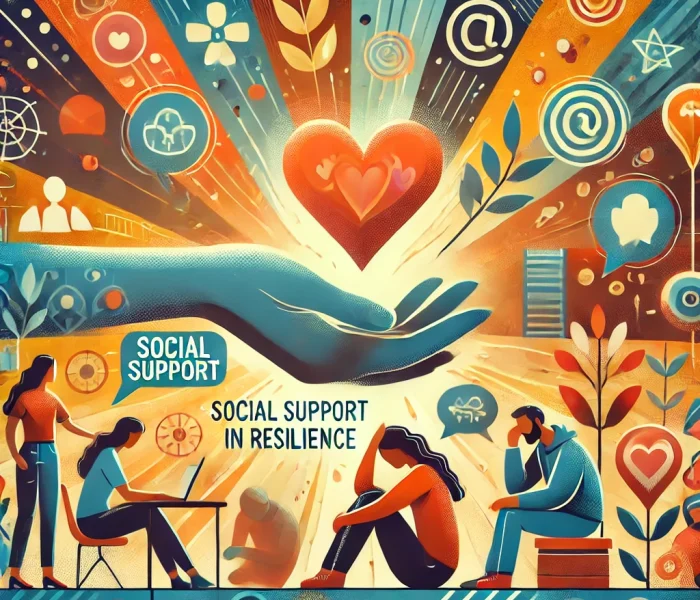In this article you will read about:
Resilience is a vital construct in understanding mental health and well-being, representing an individual’s capacity to navigate stress, adversity, and challenges effectively. The Resilience Scale for Adults (RSA) is a comprehensive tool designed to measure various dimensions of resilience. One of its critical dimensions is Social Support, which measures the perceived availability and quality of social support from friends and significant others. This article delves into the dimension of Social Support, exploring its components, significance, and implications for resilience.
Understanding Social Support
Social Support refers to the emotional, informational, and practical assistance received from social networks, including friends, family, and significant others. It is a critical factor in resilience, providing individuals with the resources needed to cope with stress and adversity (Cohen & Wills, 1985). Social Support can be categorized into various types, each contributing uniquely to resilience.
1. Types of Social Support
Emotional Support Emotional support involves expressions of empathy, love, trust, and caring. It provides individuals with a sense of belonging and security, which are essential for psychological well-being (Thoits, 1995). Emotional support helps individuals feel valued and understood, reducing feelings of isolation and promoting resilience.
Informational Support Informational support includes advice, guidance, and information that helps individuals navigate challenges and make informed decisions. This type of support enhances problem-solving skills and provides individuals with the knowledge needed to cope with adversity (House, 1981).
Practical Support Practical support, also known as instrumental support, involves tangible assistance such as financial help, childcare, or help with daily tasks. This support reduces the burden of practical challenges, allowing individuals to focus on emotional and psychological recovery (Tardy, 1985).
“Not all of us can do great things, but we can do small things with great love.”
Mother Teresa Tweet
“We think sometimes that poverty is only being hungry, naked, and homeless. The poverty of being unwanted, unloved, and uncared for is the greatest poverty. We must start in our own homes to remedy this kind of poverty.”
Mother Teresa Tweet
2. The Role of Social Support in Resilience
Social support plays a significant role in resilience by providing individuals with the resources needed to cope with stress and adversity. It enhances psychological well-being, promotes adaptive coping strategies, and buffers against the negative effects of stress (Cohen, 2004). Social support also fosters a sense of community and belonging, which are essential for resilience.
Buffering Hypothesis The buffering hypothesis suggests that social support protects individuals from the adverse effects of stress by providing resources and reducing the perception of stress (Cohen & Wills, 1985). When individuals perceive high levels of social support, they are more likely to view challenges as manageable and less threatening, enhancing their resilience.
Main Effect Hypothesis The main effect hypothesis posits that social support has a direct positive impact on well-being, regardless of stress levels (House, 1981). According to this hypothesis, individuals with strong social networks experience better overall mental health and life satisfaction, contributing to their resilience.
3. Measuring Social Support in the RSA
The RSA assesses social support through items that evaluate the perceived availability and quality of support from friends and significant others. These items help identify individuals who have access to strong social networks and high-quality support, contributing to their overall resilience.
Significance of Social Support in Resilience
The dimension of Social Support is vital for understanding and enhancing resilience. The perceived availability and quality of social support from friends and significant others contribute uniquely to an individual’s capacity to withstand and recover from adversity.
Emotional Support and Resilience
Emotional support is a cornerstone of resilience, providing individuals with the emotional resources needed to cope with stress and adversity. When individuals feel loved and valued by their social networks, they are more likely to have a positive self-concept and a strong sense of self-worth, which are essential for resilience (Thoits, 1995).
Impact on Mental Health Emotional support has a profound impact on mental health, reducing the risk of depression, anxiety, and other psychological disorders (Kawachi & Berkman, 2001). It enhances emotional regulation and promotes positive affect, which are crucial for coping with adversity.
Development of Emotional Support Emotional support develops through consistent expressions of empathy, care, and understanding within social networks. Positive reinforcement, active listening, and empathetic responses contribute to strong emotional bonds among friends and significant others (Reis & Collins, 2000).
Informational Support and Resilience
Informational support enhances resilience by providing individuals with the knowledge and guidance needed to navigate challenges. It empowers individuals to make informed decisions and develop effective coping strategies (House, 1981).
Role in Problem-Solving Informational support plays a critical role in problem-solving, helping individuals identify solutions and resources. Access to accurate and timely information reduces uncertainty and promotes confidence in handling adversity (Thoits, 1995).
Development of Informational Support Informational support develops through sharing experiences, advice, and guidance within social networks. Trust and openness in relationships are essential for the exchange of information and support (Cutrona & Russell, 1990).
Practical Support and Resilience
Practical support provides individuals with tangible resources needed to manage daily challenges. It reduces the burden of practical stressors, allowing individuals to focus on emotional and psychological recovery (Tardy, 1985).
Impact on Daily Functioning Practical support significantly impacts daily functioning by providing assistance with tasks such as childcare, financial help, and transportation. This support alleviates practical burdens, enhancing overall well-being and resilience (House, 1981).
Development of Practical Support Practical support develops through reciprocal relationships and mutual assistance within social networks. Strong social bonds and a sense of community foster the exchange of practical support (Berkman & Glass, 2000).
Enhancing Social Support
Enhancing social support involves creating opportunities for social interaction, fostering supportive environments, and encouraging participation in social activities. Community programs, support groups, and social clubs can provide platforms for individuals to connect with others and build meaningful relationships (Cohen, 2004).
Building Emotional Support
Interventions to Boost Emotional Support Interventions aimed at boosting emotional support focus on enhancing empathy, active listening, and expressions of care. Counseling, support groups, and social skills training can help individuals develop these skills (Reis & Collins, 2000).
Creating Supportive Environments Creating supportive environments involves fostering a culture of empathy and inclusivity within communities. Encouraging open dialogue, promoting mental health awareness, and providing resources for emotional support can enhance social support networks (Kawachi & Berkman, 2001).
Enhancing Informational Support
Providing Access to Information Enhancing informational support involves providing access to accurate and timely information. Educational programs, workshops, and online resources can empower individuals with the knowledge needed to cope with adversity (Cutrona & Russell, 1990).
Encouraging Knowledge Sharing Encouraging knowledge sharing within social networks fosters a culture of support and collaboration. Mentoring programs, peer support groups, and community forums can facilitate the exchange of information and guidance (House, 1981).
Strengthening Practical Support
Developing Community Resources Strengthening practical support involves developing community resources that provide tangible assistance. Community centers, non-profit organizations, and volunteer programs can offer services such as childcare, transportation, and financial aid (Berkman & Glass, 2000).
Promoting Reciprocity in Relationships Promoting reciprocity in relationships encourages mutual assistance and support within social networks. Building a sense of community and fostering trust among members can enhance the exchange of practical support (Tardy, 1985).
Implications for Research and Practice
Understanding the dimension of Social Support has significant implications for research and practice. By identifying strengths and areas for improvement within this dimension, researchers and practitioners can develop targeted interventions to enhance resilience.
Research Implications
Research on Social Support can provide valuable insights into the mechanisms underlying resilience. Longitudinal studies can explore how emotional, informational, and practical support interact and contribute to resilience over time. Additionally, research can investigate the effectiveness of various interventions aimed at enhancing social support (Thoits, 1995).
Practical Applications
In practice, assessing Social Support through the RSA can help clinicians and educators identify individuals who may benefit from targeted support. Personalized interventions can be designed to strengthen emotional, informational, and practical support networks, ultimately enhancing overall resilience. This approach can be particularly beneficial in therapeutic settings, educational programs, and organizational development (Cohen, 2004).
Conclusion
The dimension of Social Support in the RSA is a critical aspect of resilience, encompassing emotional, informational, and practical support. Each of these components plays a vital role in how individuals interact with their social networks and respond to adversity. By understanding and enhancing Social Support, individuals can build a robust foundation for resilience, improving their ability to cope with and recover from life’s challenges. Future research and practical applications should continue to focus on developing and implementing strategies that support and strengthen this essential dimension of resilience.
Social Support Book Recommendations
Here is a collection of the best books on the market related to social support:
Our commitment to you
Our team takes pride in crafting informative and well-researched articles and resources for our readers.
We believe in making academic writing accessible and engaging for everyone, which is why we take great care in curating only the most reliable and verifiable sources of knowledge. By presenting complex concepts in a simplified and concise manner, we hope to make learning an enjoyable experience that can leave a lasting impact on our readers.
Additionally, we strive to make our articles visually appealing and aesthetically pleasing, using different design elements and techniques to enhance the reader’s experience. We firmly believe that the way in which information is presented can have a significant impact on how well it is understood and retained, and we take this responsibility seriously.
Click on the icon to see all your thoughts in the Dashboard.
Your Thoughts about Social Support
It’s highly recommended that you jot down any ideas or reflections that come to mind regarding social support, including related behaviours, emotions, situations, or other associations you may make. This way, you can refer back to them on your Dashboard or Reflect pop-ups, compare them with your current behaviours, and make any necessary adjustments to keep evolving. Learn more about this feature and how it can benefit you.
References
- Berkman, L. F., & Glass, T. (2000). Social integration, social networks, social support, and health. In L. F. Berkman & I. Kawachi (Eds.), Social epidemiology (pp. 137-173). Oxford University Press.
- Cohen, S. (2004). Social relationships and health. American Psychologist, 59(8), 676-684. https://doi.org/10.1037/0003-066X.59.8.676
- Cohen, S., & Wills, T. A. (1985). Stress, social support, and the buffering hypothesis. Psychological Bulletin, 98(2), 310-357. https://doi.org/10.1037/0033-2909.98.2.310
- Cutrona, C. E., & Russell, D. W. (1990). Type of social support and specific stress: Toward a theory of optimal matching. In I. G. Sarason, B. R. Sarason, & G. R. Pierce (Eds.), Social support: An interactional view (pp. 319-366). John Wiley & Sons.
- House, J. S. (1981). Work stress and social support. Addison-Wesley.
- Kawachi, I., & Berkman, L. F. (2001). Social ties and mental health. Journal of Urban Health, 78(3), 458-467. https://doi.org/10.1093/jurban/78.3.458
- Reis, H. T., & Collins, N. (2000). Measuring relationship properties and interactions relevant to social support. In S. Cohen, L. Underwood, & B. Gottlieb (Eds.), Social support measurement and intervention (pp. 136-194). Oxford University Press.
- Tardy, C. H. (1985). Social support measurement. American Journal of Community Psychology, 13(2), 187-202. https://doi.org/10.1007/BF00905728
- Thoits, P. A. (1995). Stress, coping, and social support processes: Where are we? What next? Journal of Health and Social Behavior, 36(Extra Issue), 53-79. https://doi.org/10.2307/2626957




